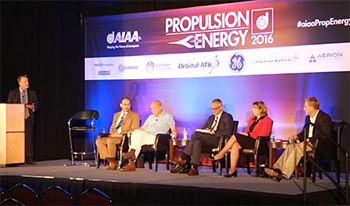Nuclear Power Could Fuel America’s Space Future Written 26 July 2016
Panelists: Moderator Lee Mason, principal technologist for power and energy storage, Space Technology Mission Directorate, NASA; Rex Geveden, chief operating officer, BWX Technologies Inc.; John Casani, Jet Propulsion Laboratory (retired); Leonard Dudzinski, Science Mission Directorate, NASA; Susan Voss, president, Global Nuclear Network Analysis LCC; Patrick McClure, project lead for reactor development, Los Alamos National Laboratory
By Duane Hyland, AIAA Communications (2008-2017)

As America’s space program continues to send exploration missions farther into our solar system, it is becoming apparent that nuclear power — either in the form of radioisotope power systems, fusion reactors, or fission reactors — can play a significant role in powering those missions, according to a panel of experts July 26 at the 2016 AIAA Propulsion and Energy Forum in Salt Lake City.
The majority of space missions are solar-powered; however, as Leonard Dudzinski, with NASA’s Science Mission Directorate, pointed out, “Once you get to Jupiter, you have one-twenty-fifth of the sun’s solar rays available to you, and when you get to Saturn, it’s one-one-hundreth of the rays,” making solar power impractical for deep solar system exploration.
Rex Geveden, chief operating officer for BWX Technologies Inc., said that besides being able to explore farther out and for longer durations, nuclear-fueled systems can cut down on the transit speed between Earth and Mars by “one to two months.”
However, high cost diminishes the promise of nuclear power in space. The U.S. space program uses plutonium-238, which is only available from Russia and, according to John Cassani, an independent consultant formerly employed at NASA’s Jet Propulsion Laboratory, costs “$3 million per kilogram (2.2 pounds),” making it very expensive to use.
Dudzinski said that the high fuel costs result in missions costing, on average, $400 million to mount, making them unattractive to most planners. Additional barriers to greater use include fuel weight to energy output, negative attitudes toward nuclear energy in general, and a lack of visionary leaders who are willing to use nuclear power more widely in missions.
As a way of reducing costs, the panelists recommended switching to uranium-based systems, since uranium is cheaper at $2,500 per kilogram, widely produced, and easily integrated.
Susan Voss, president of Global Nuclear Network Analysis LCC, said the new “kilopower” system currently under study promises to use highly enriched uranium to power spacecraft and promises to be cheaper, even more reliable, and more palatable to end users than existing systems.
